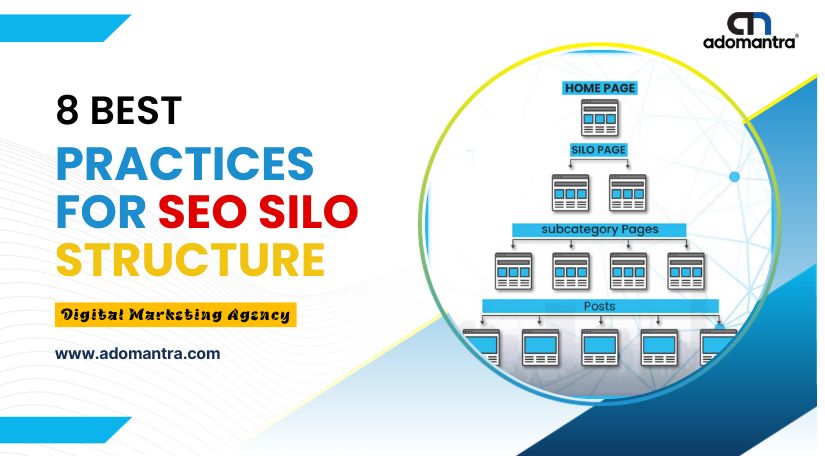
8 Best SEO Silo Structure and How to Implement One
In today's digital era, the art and science of Search Engine Optimization (SEO) have become paramount for businesses and individuals alike to gain visibility online. Every second, millions of searches are conducted on platforms like Google, Bing, and Yahoo, with users seeking answers, services, products, and much more. Being prominent in these search results is not just about having a website; it's about ensuring your content is both relevant to search queries and organized in a manner that search engines can easily understand.
Enter the concept of an SEO Silo Structure—a strategic method of grouping and organizing your website's content to enhance its readability for both users and search engines. Much like how a grain silo in agriculture stores and segregates different types of grains, an SEO Silo serves to compartmentalize your content based on themes or topics, ensuring a streamlined flow of information and improving the overall website hierarchy. This not only bolsters user experience but also can significantly influence how search engines rank your pages. Dive in as we unravel the intricacies of the SEO Silo Structure and guide you on how to adeptly implement one for your website.
What is an SEO Silo Structure?
At the heart of the digital realm, where content reigns supreme, lies the quest for both clarity and relevance. The SEO Silo Structure stands as a beacon in this journey, offering a systematic and intuitive way to arrange the vast expanse of content on websites. But what exactly does it entail?
- Definition and Basic Understanding: In essence, an SEO Silo Structure is a methodical approach to categorize, organize, and interlink content on a website based on related themes and topics. This structure draws clear boundaries between different content areas, making it easier for search engines to crawl, index, and understand the purpose and relevance of each section of the site.
- The Analogy of a Silo in Agriculture: To visualize the concept more tangibly, think of the agricultural silos that punctuate the countryside. These tall structures store different grains, segregating wheat from barley, corn from oats. Each grain has its specific compartment, ensuring purity and ease of access. Similarly, an SEO Silo Structure compartmentalizes content, ensuring that articles, blogs, or product listings on similar themes or topics are grouped together, creating a seamless user experience and a clear path for search engine bots.
- Importance in Organizing Website Content Thematically: Thematic organization is not merely for aesthetic or superficial tidiness. A well-implemented SEO Silo Structure serves a deeper purpose. For users, it fosters a more intuitive navigation experience, allowing them to effortlessly find the information they seek. For search engines, a thematic structure signals clarity, relevance, and authority, potentially boosting the website's rankings. Moreover, by reducing topic overlap and keyword cannibalization, silos ensure that each piece of content can shine in its rightful place, optimizing the site's overall SEO performance.
In a world overflowing with information, the SEO Silo Structure stands as a testament to the power of organization, guiding both users and search engines through the labyrinth of digital content.
Benefits of Using an SEO Silo Structure
In the vast cosmos of the internet, where websites orbit users like stars in the night sky, standing out and ensuring a meaningful user experience is paramount. Here at [Your Company Name], we believe in the transformative power of the SEO Silo Structure. A strategy rooted in logic, clarity, and a profound understanding of both human behavior and search engine algorithms, its benefits are manifold. So, why do we advocate for the implementation of an SEO Silo Structure? Here are the compelling reasons:
- Improved Website Navigation for Users A website should be more than just a repository of information; it should be a journey. With the SEO Silo Structure, we ensure that this journey is intuitive and delightful. By thematically organizing content, users can effortlessly traverse from one topic to another, finding exactly what they're looking for with ease.
- Enhanced Website Crawling by Search Engine Spiders Search engines are the bridge between your content and potential visitors. The SEO Silo Structure ensures this bridge is robust and clear. By compartmentalizing related content, search engine spiders can more efficiently crawl and index pages, ensuring that your content gets the visibility it deserves.
- Clear Content Hierarchy Leading to Higher Domain Authority Domain authority is a testament to a website's credibility and relevance. A well-implemented SEO Silo Structure organizes content in a clear hierarchy, signaling to search engines that the website is well-structured and authoritative. Over time, this can boost domain authority, further enhancing search engine rankings.
- Reduced Keyword Cannibalization In the race to rank for particular keywords, it's easy for web pages to compete against each other, diluting their effectiveness. The SEO Silo Structure mitigates this by ensuring that related content is grouped and distinct, reducing the chances of multiple pages vying for the same keyword.
- Better Distribution of Page Authority and Link Equity Throughout the Site Links, both internal and external, play a pivotal role in SEO. With a siloed structure, link equity is distributed more evenly across pages. This means that even your deeper, nested pages can benefit from the authority of the main category pages, leading to a more holistic and balanced SEO strategy.
How Silo Structures Improve Website SEO
The term "silo" is borrowed from agriculture, where a silo is a structure used to store and separate different types of grain. In the context of SEO, a silo structure is about organizing and separating different types of content on a website to improve its search engine optimization (SEO). When executed properly, this digital content categorization can work wonders for your website's visibility and authority. Here's a breakdown of how silo structures benefit website SEO:
- Enhanced User Experience: At its core, a silo structure is about providing clarity and an organized path for users. Websites with clear navigation and content categorization lead to better user engagement, reduced bounce rates, and longer session durations—all positive signals to search engines.
- Thematic Relevance: Siloing groups related content together, making each segment or category of your website a mini authority on a specific topic. This thematic clustering makes it easier for search engines to understand and assign relevance to the content within each silo.
- Efficient Crawlability: Search engine spiders thrive on clarity. A well-structured website enables these crawlers to index content more efficiently, ensuring that all pages are discovered and appropriately categorized.
- Internal Linking Power: Within each silo, there's an opportunity to densely interlink related content. This not only aids users in their navigation but also distributes link equity more effectively. Pages within a silo can boost each other's authority through strategic internal linking.
- Reduced Keyword Cannibalization: With content neatly compartmentalized, there's less risk of different pages competing for the same keywords. Each silo can target a specific set of closely related keywords, minimizing overlap and internal competition.
- Clearer Calls to Action: When users are guided through a thematic journey, it's easier to lead them to a specific action, be it signing up for a newsletter, making a purchase, or any other conversion goal. This clarity can improve conversion rates, another positive signal to search engines.
- Improved Page Authority: When external links point to a page within a specific silo, the link equity can be more effectively distributed among other pages in the same silo, enhancing the overall authority of that content cluster.
- Streamlined Content Creation: With a silo structure in place, content creation becomes more strategic. Teams can focus on filling gaps within specific silos, ensuring that the website grows in a balanced and SEO-friendly manner.
An SEO silo structure is more than just a content organization tactic—it's a comprehensive strategy that touches upon various facets of SEO, from on-page optimization to off-page authority building. By viewing a website not just as a collection of pages but as a well-structured repository of interrelated topics, webmasters can optimize for both users and search engines, driving organic growth and sustained digital success.
Types of Silo Structures
In the realm of SEO and website architecture, siloing is a potent strategy to enhance both user navigation and search engine indexing. But did you know that there are different ways to implement this organizing principle? Here, we'll delve into the two primary types of silo structures and their sub-categories to give you a clearer understanding:
Physical Silos
Physical silos revolve around the tangible structure of a website, which means the actual arrangement of directories and URLs. They ensure that the site's file and folder arrangement mirrors its content hierarchy.
A. URL Structuring
- Definition: It refers to the organization of a website's URLs in a manner that reflects the thematic structure of the content.
- Example: For an e-commerce website selling apparel:
- domain.com/mens-wear/
- domain.com/mens-wear/shirts/
- domain.com/mens-wear/trousers/
- Advantages: Clear URL structures not only enhance user understanding but also give search engines a clear idea of the content's context and hierarchy.
B. Directory Organization
- Definition: This involves organizing content into specific directories or folders based on themes or topics.
- Example: On the server, you might have separate directories for 'blog', 'products', 'services', each housing related content.
- Advantages: It streamlines the website's backend management and reinforces the thematic clustering of content, aiding in efficient search engine crawling.
Virtual Silos
Unlike physical silos that rely on actual structural changes, virtual silos are about perceived organization, primarily achieved through internal linking strategies.
A. Interlinking Related Content Without Relying on URL Structure
- Definition: This approach involves linking pages with related content, forming a thematic chain without altering the URL structure.
- Example: A blog post about "summer fashion trends" could link to another post about "best summer fabrics", even if their URLs don't follow a strict hierarchical pattern.
- Advantages: Enhances user navigation by directing them to related content and distributes link equity, aiding in SEO.
B. Using Breadcrumbs and In-Content Links
- Definition: Breadcrumbs provide a trail for users to follow back to the homepage. In-content links, on the other hand, are hyperlinks placed within the content to guide users to related pages.
- Example: On a page about 'woolen sweaters', breadcrumbs might look like: Home > Women's Apparel > Winter Collection > Woolen Sweaters. Additionally, within the content, there could be links to 'winter care tips' or 'matching winter accessories'.
- Advantages: Breadcrumbs enhance user navigation, helping them understand their location on the site. In-content links keep users engaged and reduce bounce rates.
List Of 8 Best Practices for SEO Silo Structure
Use a Pyramid Structure
Adopting a pyramid structure for your website is foundational to an effective SEO Silo Structure. Imagine the pyramid's base as your homepage, the next tier as primary categories, the subsequent levels as sub-categories, and finally, the top as individual content pieces.
Benefits:
- Clear Hierarchy: Much like the ancient pyramids, which have a broad base narrowing to a peak, this structure ensures every piece of content has its designated place, facilitating easy navigation.
- Streamlined Navigation: Users can seamlessly move from broad topics (base) to specific content (peak), enhancing their experience and reducing bounce rates.
- SEO Optimization: Search engines can more easily understand and index a site with a clear hierarchy. This pyramid approach signals the importance and relation of pages to search engines, potentially improving rankings.
Implementation Tips:
- Consistent Structure: Ensure that each level of your pyramid has a consistent number of categories or sub-categories. Avoid overly broad or overly narrow tiers.
- Logical Flow: The progression from the base to the peak should be logical and intuitive. For example, an e-commerce site might progress from 'Clothing' to 'Men's Wear' to 'Suits' to 'Single-Breasted Suits'.
- Interlinking: Within content, provide links to related pieces, both horizontally (within the same tier) and vertically (to the tiers above and below). This reinforces the pyramid structure and guides users and search engine bots effectively.
Embracing the pyramid structure lays the groundwork for a well-organized, user-friendly, and search engine-optimized website.
Audit and Categorize Existing Content
Before diving deep into creating new content silos, it's pivotal to understand the current landscape of your website. Auditing and categorizing existing content allows for a clearer perspective on how to structure or restructure content in a way that benefits both the user and SEO.
Benefits:
- Eliminate Redundancies: Discover overlapping content or topics that could be streamlined to prevent keyword cannibalization.
- Identify Gaps: Recognize areas where your content might be lacking, providing opportunities for expansion and enhancement.
- Optimize User Experience: By categorizing and presenting content methodically, users can navigate and locate desired information swiftly and effortlessly.
Implementation Tips:
- Use Tools: Employ website crawling tools or content audit software to get a comprehensive view of all the content on your site.
- Tag and Label: As you go through each content piece, label it with relevant tags or keywords. This will make categorizing easier and offer insights into potential silos.
- Prioritize High-Quality Content: While auditing, recognize content that performs well in terms of user engagement and search engine ranking. This content can serve as pillars around which other related content can be organized.
- Consider Archiving or Updating: Some content may be outdated or irrelevant. Decide whether it's best to update these pieces or archive them to declutter the website.
In essence, auditing and categorizing existing content is akin to taking inventory in a store. It provides a clear picture of what's on hand, what's missing, and how best to display items (or content) for maximum impact and efficiency.
Organize Your URL Structure
A website's URL structure isn't just a technical aspect; it's an essential component of user experience and SEO. When aligned with a physical silo strategy, URL structure can act as a clear roadmap, guiding users and search engines through the depth and breadth of your content.
Benefits:
- User Intuition: A well-organized URL structure resonates with user intuition, allowing them to predict and understand the content on a page even before they click.
- Search Engine Clarity: A logical URL hierarchy offers search engines context about a page's position within the site and its relation to other content, aiding in efficient indexing.
- Enhanced Credibility: Descriptive and structured URLs can bolster a site's credibility and professional appeal.
Implementation Tips:
- Consistency is Key: Stick to a consistent naming convention. For example, use hyphens to separate words in URLs and keep the case uniform (typically lowercase).
- Descriptive, Not Lengthy: URLs should describe the content without being overly verbose. Avoid generic terms and focus on meaningful keywords.
- Reflect Content Hierarchy: Ensure that the URL structure echoes the content's pyramid structure. For instance,
domain.com/category/sub-category/page-title. - Avoid Deep Nesting: While reflecting hierarchy is important, avoid excessively deep URL structures. A depth of 3-4 levels is often optimal for user experience and SEO.
- Minimize URL Parameters: Excessive use of parameters can make URLs unwieldy and less SEO-friendly. Where possible, opt for static, descriptive URLs.
By effectively organizing your URL structure in line with physical silos, you pave a clear path for users and search engines, enhancing navigation, and optimizing search performance.
Internal Linking
Internal linking is the act of connecting various pages within your website. Think of it as the intricate web of connections that hold your site's content together, directing users and search engines from one piece to another. When implemented correctly, internal linking can supercharge navigation and SEO efforts, especially in a siloed structure.
Benefits:
- Boost User Navigation: Strategic links can guide users to related or more in-depth content, enhancing their browsing experience and prolonging site engagement.
- Distribute Page Authority: Internal links pass on SEO value or "link juice" from one page to another. This can help elevate lesser-known pages by drawing authority from more established ones.
- Reinforce Content Themes: Linking related articles or pages strengthens thematic silos, making it clear to search engines and users the interconnectedness of content.
- Lower Bounce Rates: Effective internal linking can keep users engaged for longer, reducing the chances of them leaving the site after viewing just one page.
Implementation Tips:
- Use Descriptive Anchor Text: Instead of generic phrases like "click here", use meaningful and keyword-rich anchor text that describes the linked content.
- Avoid Over-Linking: While internal linking is beneficial, it's crucial not to overdo it. Ensure links are relevant and add value to the user's experience.
- Diversify Link Targets: Don’t always link to the same few pages. Spread out internal links to cover a broader range of your content, ensuring that every page gets its share of internal linking love.
- Follow a Natural Flow: Links should be integrated seamlessly into the content. They should make sense contextually and not appear forced.
- Regularly Audit Internal Links: Over time, content may be updated, moved, or removed. Regular audits can identify broken or outdated links that need fixing.
Internal linking is more than just a technical SEO practice. It's an art of connecting content in ways that enrich the user's journey, making it more informative, engaging, and rewarding. When intertwined with an SEO silo structure, it can significantly amplify a website's overall effectiveness.
Implement Breadcrumbs
Breadcrumbs are a navigational aid, providing users with a trail to trace their journey from the page they are currently on back to the homepage. They offer a snapshot of how the website hierarchy is organized, mimicking a step-by-step path. In the context of SEO and user experience, breadcrumbs are invaluable.
Benefits:
- Enhanced User Navigation: Breadcrumbs give users an easy way to backtrack or jump to higher-level sections without feeling lost or having to rely solely on the back button.
- SEO Advantages: Search engines utilize breadcrumbs to understand and index the website structure. Additionally, breadcrumbs can appear in search results, offering users more context.
- Reduced Bounce Rates: By providing users with more navigational options, there's a higher likelihood of them exploring more content, thereby reducing bounce rates.
- Contextual Clarity: Breadcrumbs clarify the relationship and hierarchy between pages, giving users an immediate understanding of where they are within the site's structure.
Implementation Tips:
- Positioning Matters: Typically, breadcrumbs are placed at the top of the page, below the navigation bar but above the content, making them easily noticeable.
- Use the Right Separator: Common separators between breadcrumb elements include ">" and "/". Ensure it's consistent and clear.
- Keep It Simple: Breadcrumbs should be concise. Use short, descriptive terms for each level.
- Integrate Schema Markup: By integrating breadcrumb-specific schema markup, you can enhance the way your breadcrumbs display in search engine results.
- Avoid on Homepage: Since the homepage is the starting point, breadcrumbs are redundant there. Start them on secondary pages.
Incorporating breadcrumbs is like placing signposts on a hiking trail. They may seem insignificant at first, but they offer direction, context, and reassurance, making the journey more enjoyable and less confusing. In the digital landscape, they can be the difference between a user feeling lost or feeling at home on your website.
Update XML Sitemap
An XML sitemap serves as a roadmap of your website, detailing all significant pages and their relationships. Especially crucial for search engines, it aids in the efficient crawling and indexing of your site. When restructuring or employing an SEO silo, updating the XML sitemap is paramount.
Benefits:
- Swift Indexing: An updated sitemap ensures that search engines promptly recognize and index new or modified content, accelerating its appearance in search results.
- Prioritization: Through sitemaps, you can indicate to search engines which pages of your site are the most important, influencing the frequency and depth of crawls.
- Error Identification: Search engines often use sitemaps as a reference. If there's a discrepancy between the sitemap and actual site content, it can help in identifying crawl errors or issues.
- Better SEO: An accurate and comprehensive sitemap can bolster SEO by ensuring that all valuable content gets its due attention from search engines.
Implementation Tips:
- Automatic Updates: Use plugins or tools that automatically update the XML sitemap whenever new content is added or existing content is modified.
- Organize Hierarchically: Structure the sitemap to mirror your website's hierarchy, ensuring it follows the silo structure you've implemented.
- Limit Size: Very large sitemaps can be split into smaller, categorized sitemaps. Ensure that no single sitemap exceeds 50,000 URLs or is larger than 50MB.
- Submit to Search Engines: Once updated, submit your sitemap to major search engines like Google and Bing through their respective webmaster tools.
- Stay Updated on Protocol: The sitemap protocol might evolve or change. Stay updated to ensure your sitemap meets current standards and practices.
Remember, while an XML sitemap is primarily for search engines, its effectiveness directly impacts users by determining how easily they can find your content through search. Keeping it current is a simple yet impactful way to ensure that both search engines and users navigate your site's content with ease.
Create Content Hubs for Blog Content
Content hubs are centralized areas on your website where users can find comprehensive information about a specific topic. These hubs are akin to a library on a particular subject, containing various related articles, infographics, videos, and other content forms. Implementing content hubs within a blog can elevate the user experience while solidifying your authority on a topic.
Benefits:
- Establish Authority: A well-curated content hub showcases your depth of knowledge on a subject, positioning you as an authority in that niche.
- Boost User Engagement: With a plethora of related content at their fingertips, users are likely to spend more time exploring, thereby increasing engagement rates.
- Enhance SEO: Centralizing content around a topic improves keyword relevance and can boost the ranking potential for those keywords. Search engines recognize the hub's thematic focus, leading to better visibility.
- Simplify Navigation: Users seeking information on a specific topic find everything they need in one place, negating the need to jump around different site areas.
Implementation Tips:
- Identify Core Topics: Begin by identifying the primary topics your blog covers. These will serve as the foundation for your content hubs.
- Cluster Related Content: Under each core topic, group related articles, videos, infographics, etc. Ensure each piece complements the central theme of the hub.
- Design with Users in Mind: The hub layout should be intuitive and user-friendly. Consider adding a table of contents, filters, or search functions to help users quickly find what they're looking for.
- Interlink Generously: Within the hub, ensure that content pieces link to each other where relevant. This not only boosts SEO but also guides the user through a journey of knowledge.
- Regularly Update: As more content is created, update the hub to include new pieces. Likewise, periodically review and refresh older content to ensure its relevance and accuracy.
By structuring your blog content into well-defined hubs, you not only make it more accessible for users but also harness the compounded SEO power of clustered, thematic content. Over time, these hubs can become the go-to resources for anyone seeking knowledge in your domain, driving consistent, high-quality traffic to your site.
Monitor and Adjust
Like any strategic endeavor, the effectiveness of an SEO silo structure isn't set in stone upon its initial implementation. Digital landscapes evolve, search engine algorithms change, and user behaviors shift. Monitoring performance and making periodic adjustments is essential to ensure continued success and relevancy.
Benefits:
- Stay Relevant: Continuous monitoring ensures that your website remains updated with current trends, search patterns, and algorithm changes.
- Optimize Performance: By tracking metrics, you can identify what's working and what's not, allowing for refinements that can lead to better outcomes.
- Maximize ROI: Ensuring your SEO silo structure stays optimized can lead to increased organic traffic, better user engagement, and ultimately, higher conversions.
- Prevent Issues: Regular monitoring can help in early detection of potential problems, like broken links or indexing issues, before they escalate.
Implementation Tips:
- Use Analytics: Employ tools like Google Analytics to track key performance indicators, such as page views, bounce rates, and conversion metrics related to your siloed content.
- Monitor Keyword Rankings: Keep an eye on how your content ranks for targeted keywords. Drops in rankings can indicate areas that need revisiting or optimization.
- Gather User Feedback: Engage with your audience to gather insights. User feedback can offer valuable information on navigational issues, content gaps, or areas of improvement.
- Conduct Periodic Audits: Every few months, conduct a thorough website audit. Check for broken links, crawl errors, duplicate content, and other technical issues that might affect SEO.
- Stay Updated: SEO is a dynamic field. Regularly educate yourself on the latest best practices, algorithm updates, and industry trends to ensure your silo structure remains effective.
Ultimately, the key lies in striking a balance between proactivity and reactivity. While it's essential to be forward-thinking and proactive in optimizing the SEO silo structure, it's equally crucial to react promptly to any challenges or changes the digital world presents. By adopting a mindset of continuous learning and adaptation, you can ensure that your website remains a dynamic and impactful entity in the vast digital ecosystem.
Common Mistakes to Avoid
Navigating the complex world of SEO and, in particular, silo structures, can sometimes lead to missteps, even for seasoned professionals. Being aware of these pitfalls is half the battle. Here, we delve into some frequent mistakes website owners make when trying to silo their content and how to sidestep them.
- Overcomplicating the Silo Structure: The idea behind a silo is to introduce clarity and organization. However, some fall into the trap of creating a multi-layered, convoluted structure that confuses both users and search engines. A silo should simplify the user's journey, not make it labyrinthine.
- Solution: Keep it straightforward. While it's essential to have a detailed structure, avoid unnecessary subdivisions. Ensure each layer of the silo has a clear purpose and adds value to the overall user experience.
- Neglecting to Interlink Within Silos: The strength of a silo lies in its interconnectedness. Forgetting to interlink related content within a particular silo can weaken its thematic relevance and SEO poten
- cy.
- Solution: Regularly review content within each silo to ensure relevant internal linking. Tools like website crawlers can help identify missed linking opportunities. Remember, the goal is to guide the user through a cohesive journey on a specific topic.
- Creating Too Broad or Too Narrow Categories: Striking the right balance when defining your silos is crucial. Overly broad categories can dilute the thematic focus, while exceedingly narrow ones can fragment content and confuse users.
- Solution: Before finalizing categories, conduct keyword and topic research. This can give insight into how your target audience searches for content and which subjects have enough depth to warrant their own silo. Periodically revisit and adjust categories based on user behavior and content growth.
In essence, while the SEO silo structure is a powerful tool, it's vital to wield it with precision and thoughtfulness. Avoiding these common mistakes ensures your website remains user-centric, organized, and primed for optimal search engine performance.
Conclusion
The digital landscape is vast, teeming with information vying for users' attention. Amidst this digital cacophony, an effective "SEO silo structure" emerges as a beacon, illuminating a clear path for users and search engines alike. By categorizing and interlinking related content, a well-implemented silo structure ensures that websites are not only user-friendly but also optimized for search engine performance. From understanding the foundational concepts to recognizing common pitfalls, this guide has endeavored to provide a comprehensive overview of the significance and implementation of an SEO silo structure. It's not just about organizing content; it's about creating a cohesive, thematic experience that enhances user engagement, boosts SEO, and ultimately, drives conversions.







